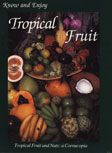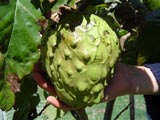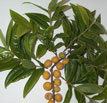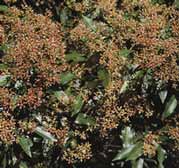 December 2003
December 2003
The Daley News
Festive Greenings to you all. Many well wishes throughout the silly season to you all and I do hope that your orchard is dripping with fruit to meet the festivities. I have changed the newsletter a little from my orginal projection. If you were in anticipation for a particular article, don't worry it is on its way.
SPECIAL CHRISTMAS OFFER -
We have a new addition to the range of books available from Daleys Nursery. "Know  and Enjoy Tropical Fruits" by James J Darley is a colourful and creative display of what to do with the abundance of fruits in your tropical orchard. With 333 tantalizing recipes from Baked Mammey Sapote Cheesecake to Candlenut and Zucchini Bread, there isn't any rarity that isn't covered. There is also botanical info and fruiting calanders. I can assure you is has over taken my adventuristic ego in the kitchen.
and Enjoy Tropical Fruits" by James J Darley is a colourful and creative display of what to do with the abundance of fruits in your tropical orchard. With 333 tantalizing recipes from Baked Mammey Sapote Cheesecake to Candlenut and Zucchini Bread, there isn't any rarity that isn't covered. There is also botanical info and fruiting calanders. I can assure you is has over taken my adventuristic ego in the kitchen.
As a Christmas special we are offering this book for $29.75 usually $39.95 with free postage and handling and Christmas gift wrapping
(if required). The perfect gift for someone that has a tropical fruit carpet in their orchard and are wonreding whats next. We will also be running our Christmas Special of Louis Glowinskis popular book "Complete Fruit Growing in Australia" for $29.75 usually $49.50
Gift Vouchers for Mail Order Delivery also available as the perfect gift for a growing future. We can contact your recipient and make arrangements for delivery before Xmas if you respond Now.
Stretching the limits - Growing in subtropicals in temperate areas
We recieve numerous emails of customers sharing their trials and celebrations of growing tropical fruits in marginal areas. This newsletter I thought I would hand it over to the gardeners / growers down south to tell their stories.
 There you go, this ones a "White", I bought it off you a few years ago, that's inspiration for your next newsletter, grown at 39 degrees South, 360 km's south west of Melbourne in an open paddock, none of this heat island effect cheating that's going on in the city. White is not really the best choice for growing in cold climates but it's the most easy to get variety and happens to be the first I got and is the largest tree I have. Then again I would say Northern N.S.W is just as much out of the ideal cherimoya range as I am but in the other direction so it's ok. I'm still working on getting a mango to go but it's a slight technical problem right now, Sapotes and Avocados as you would expect are no problem, cherimoyas are a bit closer to the limits and get a bit beaten up over Winter but still come good in Spring and manage to grow a few feet a year
There you go, this ones a "White", I bought it off you a few years ago, that's inspiration for your next newsletter, grown at 39 degrees South, 360 km's south west of Melbourne in an open paddock, none of this heat island effect cheating that's going on in the city. White is not really the best choice for growing in cold climates but it's the most easy to get variety and happens to be the first I got and is the largest tree I have. Then again I would say Northern N.S.W is just as much out of the ideal cherimoya range as I am but in the other direction so it's ok. I'm still working on getting a mango to go but it's a slight technical problem right now, Sapotes and Avocados as you would expect are no problem, cherimoyas are a bit closer to the limits and get a bit beaten up over Winter but still come good in Spring and manage to grow a few feet a year
Jason
Hi Emma,
Just to let you know that most of the last batch of plants have been planted out. Once again, all were received in great condition, and really safely packed, we really appreciate it. And we'd be happy to let you know how the subtropic plants do here in Canberra! I don't think I've EVER heard of anyone growing casimiroa here. No-one I know has even heard of it.
Now the plants are starting to wake up (although tonight is really chilly, the weather really ping-pongs between hot and cold), we should get a better idea of how these plants are going to behave here. We'd be happy to let you know in greater detail about how they do - it may even be encouraging for other cold climate gardeners.
I was browsing in Kmart's garden section not so long ago when I over heard one elderly customer say to young mum who was looking at citrus, not to bother, that 'Meyer' is the only citrus that will grow down here... But we've planted lemonade, mandarins, Tahitian lime, and blood oranges, though, and can vouch for the frost hardiness of these plants. We had a week of -9C, and the worst that happened was that the lime lost a number of its leaves. I'm told that 'officially', something is considered frost hardy if it endures -7C, so this is not bad! My only suggestion would perhaps be, that given the late frosts, citrus that have later blooming seasons might be useful, so that blossoms don't get damage.
Just as the Lime did, Casimiroa lost leaves at -9C (flourished to -5C), but is now putting out strong growth. The Cape gooseberry died back completely and is resprouting from the base. Lemongrass and Thai Coriander are also resprouting from the base. The resprouting plants all really like the lucerne loosely piled up around the base. All the beds are mulched with lucerne. Despite severe frosts, Strawberry guava is acting like nothing happened. Magenta cherry and ceylon gooseberry did fine until -5, but expired after this. Everything is still very exposed, but I look forward to seeing the trees grow, and working with the shade/light, warm/cold as the various microclimates develop in the garden.
Acerola, even with shelter, simply dislikes cold weather, we said goodbye to this a while back! And the Brazilian cherry was accidentally left outside...well, misplaced and forgotten rather, and endured frost after frost before I got to wondering about it. The leaves turned burgundy, and eventually dropped off (not all), but once it was back in shelter, what seemed like deadwood started sprouting small green leaves. It's under the eave, against a north wall now, and is tentatively growing back. This little bush is a lot hardier than I thought!
Avocado, in a tub on the northside, gets a hessian blanket for the frosts, and is sporting many new buds. It tolerated the cold, with protection from the frost. Monstera though...one night of frost did it in! It never recovered. But Mum's is doing fine under the eave of the house, on the northside. So some warm bricks and over hanging shelter, not to mention all the other bushy things growing around it, would have helped. Also read elsewhere that Camellia sinensis is frost hardy only to -6C, although I did spot new growth on our little twig *after* it lost its leaves to -9C, and *before* it was stomped on by a helpful toddler learning to garden. Frost hardiness is one thing...but will they set fruit? We'll have to wait and see...
We'd be happy to take some 'in progress' shots with all the daleys' trees in our garden! It would be even better if we could find a 'before' shot, though, to appreciate the difference some nice soil and beautiful trees make to a barren (really barren!), rocky slope. It's certainly not as speedy a process as a TV make-over, but really satisfying! Even in the half finished state (when is a garden ever really 'finished' anyway?) we often look gratefully out at our fledgling garden and smile.
Hope to take some photos soon.
Cheers, and many thanks,
Ivana & Marian.
Over the last few years Ivana has gone where no gardener has gone before (in Canberra anyway). Inevitably there have bee some losses but not enough to dampen her enthusiasm for her cross climate experiments.
Our Exotic Fruit of the Month
YELLOW JABOTICABA, Myciaria glomurata
The Exotic fruit special for this month is the Yellow Jaboticaba. We consider this tree a showpiece. Its lime green leaves have an unusual soft, almost powdery appearance and its beautiful golden green pendulous branches make it a worthy feature in the garden for its highly ornamental nature.
The fruit of the black jaboticaba is becoming more popular and widespread (I even found some on the shelf of a local grocery store here in Lismore last week) while the yellow jaboticaba still remains a mystery to many.
A prerequisite for enjoying the fruits of the Black Jaboticaba is patience. They can often take 6-7 years to come to fruit. However, we have found the Yellow Jabot produce fruit in as little as 3 years.
 It is a small bushy tree, usually growing to 3-4m in the subtropics of Australia, however I have seen photographs of the tree, in Brazil (its place of origin), with a couple of young boys perched high in the branches. These trees must have reached 9-10 m tall. The tree has a moderate cold tolerance but is best protected from frost. It is a suitable container grown tree in those areas that do receive frost and can be moved to a sheltered position during the cooler months.
It is a small bushy tree, usually growing to 3-4m in the subtropics of Australia, however I have seen photographs of the tree, in Brazil (its place of origin), with a couple of young boys perched high in the branches. These trees must have reached 9-10 m tall. The tree has a moderate cold tolerance but is best protected from frost. It is a suitable container grown tree in those areas that do receive frost and can be moved to a sheltered position during the cooler months.
They are happy in full sun or part shade and are generally small enough to find a place in most gardens. They are relatively wind tolerant but will not enjoy salt spray. They particularly enjoy deep rich soil pH 5.5 to 6.5 but with regular nutrient application can be grown in most soil types.
While the fruits have some similarities to the Black Jaboticaba, they are quite different in appearance, having a slightly furry yellow skin instead of the smooth shiny black skin. The fruit contains a gelatinous whitish pulp which has a pleasant, sweet tangy flavour reminensint of pineapple. A single tree will produce fruit, but cross pollination has shown to increase productivity.
When planting a jaboticaba, the crown (uppermost) roots should be 2 to 3 inches higher than the surrounding soil levels to provide water runoff. Peat, compost or rotted manure may be mixed with the soil from the planting hole to improve it. The soil should be a well-aerated mixture.
Our Rainforest Tree of the Month
COACHWOOD, Ceratopetalum apetalum
 This small rainforest tree, native to much of Eastern Australia rainforests from cold temperate of South NSW through to cooler subtropical rainforest in southern QLD. The tree is fast growing and very hardy usually reaching 10-12m in open gardens. It is extrordinarily beautiful, flowering when still quite young with striking creamy-peach star shaped flowers. Suits as a specimen tree in park lands or rainforest gardens. This is, by far, Kaths (our rainforest specialist) favourite tree in the nursery at the moment and it would be a determined customer to not be enchanted by her Coachwood tales and leave empty handed should you visit the nursery.
This small rainforest tree, native to much of Eastern Australia rainforests from cold temperate of South NSW through to cooler subtropical rainforest in southern QLD. The tree is fast growing and very hardy usually reaching 10-12m in open gardens. It is extrordinarily beautiful, flowering when still quite young with striking creamy-peach star shaped flowers. Suits as a specimen tree in park lands or rainforest gardens. This is, by far, Kaths (our rainforest specialist) favourite tree in the nursery at the moment and it would be a determined customer to not be enchanted by her Coachwood tales and leave empty handed should you visit the nursery.
The trees listed above and many more are available at Daleys Nursery. See our website at https://www.daleysfruit.com.au.htm and go straight to the shopping trolley to order these plants or call in and see Emma at the Nursery for more information.
|
Casimiroa Cheese Slice |
|
|
Ingredients: Method: |
|
The mountain of White Sapotes that are building up underneath the trees here at the nursery have motivated this months recipe. The recipe was extracted from "Know and Enjoy Tropical Fruit" by James J Darley see below for more info on this publication
Employment opportunities
Do you feel the nursery industry is for you?
Daleys is a dynamic family run nursery, operating for over 22 years. Together, as a team we believe that growing plants is not just an occupation but a lifestyle. We share a passion for our work and a commitment to creating a lively and progressive working environment. Scroll down to see our mission statement.
Some of the career choices available at Daleys Nursery include:
Propagation Dispatch Rainforest Plant Production Retail Customer Service Sales and Administration Marketting and Promotions General Nursery Hand
Click to view Current Positions Available
Should you be interested in other aspects of the nursery, we welcome you to send your resumes through to Management as we will keep on file for 12 months.
Send your resume now
Next Issue
Drying your excess fruit
Design ideas for your orchard





